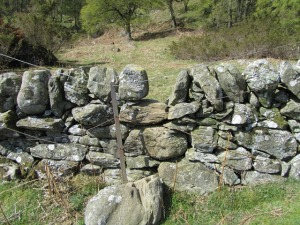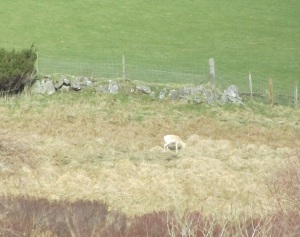
The stones at the gap in the dyke were stained and scratched with the passage of many thousands of rabbit feet
Part 2 of this day’s walk during my 2011/12 wildlife survey on a Highland Perthshire estate
Saturday 17 March 2012. Weather: Mostly sunny and warm, though quite cold when it clouded over. Wind varying light to moderate.
I continued past a netted enclosure where the keeper has some hens, wondering if he shuts them in their henhouse every night to keep them safe from foxes. Maybe he doesn’t, as there used to be seven or eight, plus a cockerel and I could only see two now. He had chain-sawed a blown oak tree into rounds for splitting, and had kindly invited me to fill my car before leaving. They looked perfect for firewood and I was pleased my car is not a showpiece. I cut along the top of Clair’s Cover, an area with a pond and where a game crop is planted each year, benefiting wild birds as well as game birds, and skirted the top of a marsh above the duck ponds, taking advantage of a wooden walkway built for the convenience of the guns at the Bericky pheasant drive. As I came off the walkway and through the small gate to the next grass field the remains of a recently-killed rabbit lay beside a dyke. It wasn’t clear what had killed the rabbit but it most certainly had been fed on at some stage by a feral cat, with the ribs eaten through and the skin pulled back, almost inside out, over the back legs in typical feline fashion. Usually cats in the wild try to hide the remains of their food by scraping some grass or leaves over it, though this hadn’t been the case here.
As I climbed the hill towards Bericky a young rabbit, the first I had seen this season, bolted into a burrow – and almost immediately peeked out again. This was a dangerous thing to do and showed its immaturity and naivety. Young rabbits leave the nest burrow around four weeks, and this one would be seven or eight weeks old. Further up the hill another young rabbit – a bit bigger and probably around ten weeks old – scurried along outside the Bericky deer fence. This one would be part of a litter born about New Year; unusual but certainly not a rarity, especially with the mild winter of 2011/12.
I walked up through Bericky without encountering anything out of the ordinary, then cut over the grass field lying to the south of Fank Wood. I am always amazed at the number of rabbits that suddenly emerge in early spring. Of course they had been here all winter but stay much more underground. In spring pairs of rabbits appear at every burrow and under every hedgerow and Cardney was no exception. White cotton tails bobbed everywhere, with nearly a dozen running from the field into Fank Wood. The rabbits knew each gap through they dyke, through which they disappeared, seconds later re-emerging running up the bank on the other side and vanishing into the trees. I next walked through a field of re-seeded grass, which was equally alive with rabbits. There is certainly plenty food here for foxes, stoats, weasels, buzzards and even scavenging red kites. I sat on a flat stone on a rough bracken-covered ridge in the centre of the field with a view over the High Larches Wood. The sun was shining and I enjoyed my ‘piece’ and juice while watching a pair of buzzards over the wood. No sign of red kites and I was a bit concerned that they might not breed on the estate this year, but it was still early days.
I circled round to get to the top end of the High Larches Wood, passing a new tunnel trap that the keeper had set and which already held its first newly-dead weasel. Though I’ve no grudge at weasels or stoats it’s an important part of game management to keep their numbers under control, though many more evade capture than those that have an instant death in the jaws of a Fenn tunnel trap. I came through the wood from the top end to the bottom, hoping to see a red squirrel as I’ve never seen one there since the autumn. No luck today, but hopefully there might still be a pair here, despite the ravaging the trees got in the high winds of winter.
I made up for the hill dyke that runs along the bottom of the Craigmore Face, where 100 or so jackdaws and a buzzard were wheeling round above the scree and the few stunted larch and birch that the face supported. Despite the proximity of the buzzard, the jackdaws paid scant attention, drowning out the mew of the buzzard with their concerted chak chakking. Ahead of me, three dark coloured fallow made their way through some birch trees towards a thick stand of junipers, where they would find shelter. I was making for a track up through the junipers to walk to the west end of Creag Bhearnach and wondered if I would meet up with them again. Five rabbits ahead of me near the corner of the grass field bolted through the open gate into the corner of a marshy area before crossing a gap in the dyke to the Craigmore face. When I reached the gate the rabbit run on the bare earth had been made smooth and shiny by the passage of hundreds of furry paws, with the occasional pinhole claw mark the only blemish on the polished earth.
I went through the gate, carefully stepping over the rabbit motorway, walked to the far end of the marsh, then through the gate to the hill and the juniper bushes. As I made my way up the track made by the keeper’s Polaris and the quad bike used by Louis, the owner’s son in law, the three dark fallow walked across in front of me, making for Creag Bhearnach wood. As I looked up to the wood to follow their progress, a red squirrel ran along a narrow larch and sat watching me from where the branch joined the tree, ready for a quick vertical escape if the need arose. As I made my way along the outside edge of the wood two rabbits came running towards me, clearly on a scent trail. They were shortly joined by a third, all of which I’m sure were bucks, and, oblivious of my presence, continued their search for an elusive doe. After running almost to my feet they re-traced their steps and, using a new tactic, split up. One hopped into the heather; one came back towards me and one jumped the dyke into the wood, where I watched it quartering like a spaniel. It was an interesting encounter and rather unusual in the fact that there seemed no animosity among the trio of lovelorn bucks.
At the far end of the wood I sat on a rock with a view of the west end of the hill and had a second sandwich, again in lovely spring sunshine. I wondered about the ailing buck that I had recently seen at this spot and of its fate. I couldn’t imagine it recovering and would be surprised if it were not now dead. I made my way back through the centre of Creag Bhearnach and halfway down the side of the Pheasant Planting without any further wildlife encounters apart from the prukk, prukk of a pair of ravens passing over. I was delighted to see the white fallow yearling again, this time feeding in the marshland that runs between the Craigmore Face and the Henhouse Strip. It was some distance away, nearer the L Wood and slowly getting nearer to the Henhouse Strip. I cut through the Henhouse Strip near the pond to come out at the far end, where I might get a better view of it. This tactic worked well, and when I came out of the wood at the gap between the Henhouse Strip and the L Wood I could see it sitting resting at the fence-side. I would get no closer without disturbing it so left it in peace. Odd that it’s on its own, though I think this is entirely natural and that there is no negative or worrying reason for its current solitude. It will be an easy deer to monitor in any case.
Seeing the white fallow again was a great end to the day, and it had been a real bonus seeing a green woodpecker at last. If my last visit was a ‘red squirrel day’ this had most certainly been a ‘rabbit day’.

